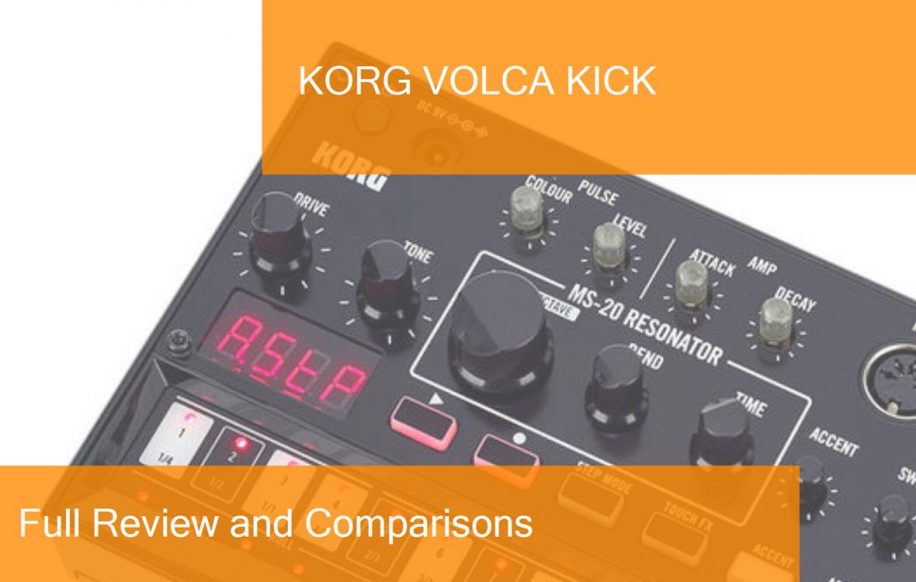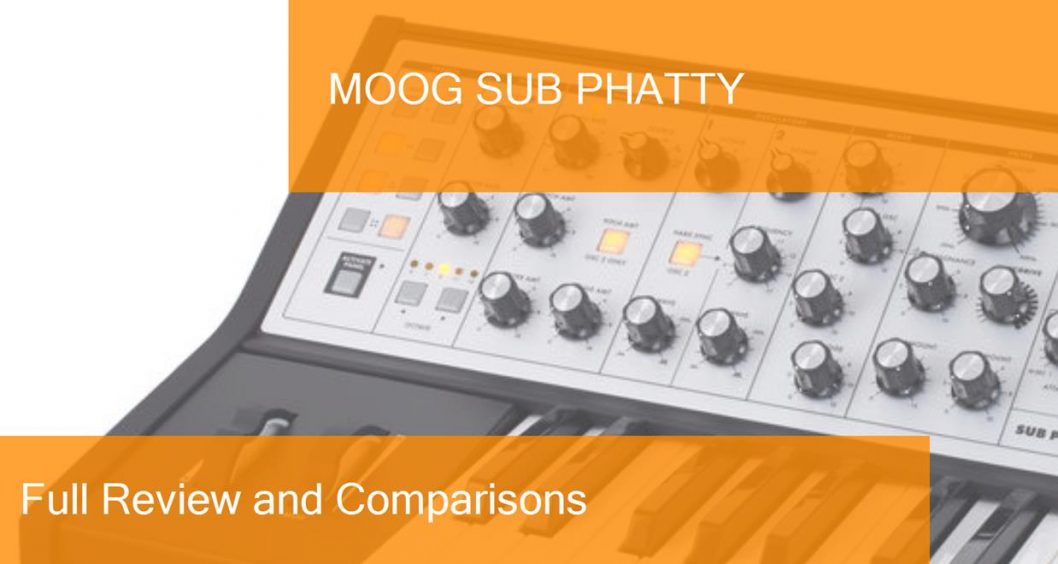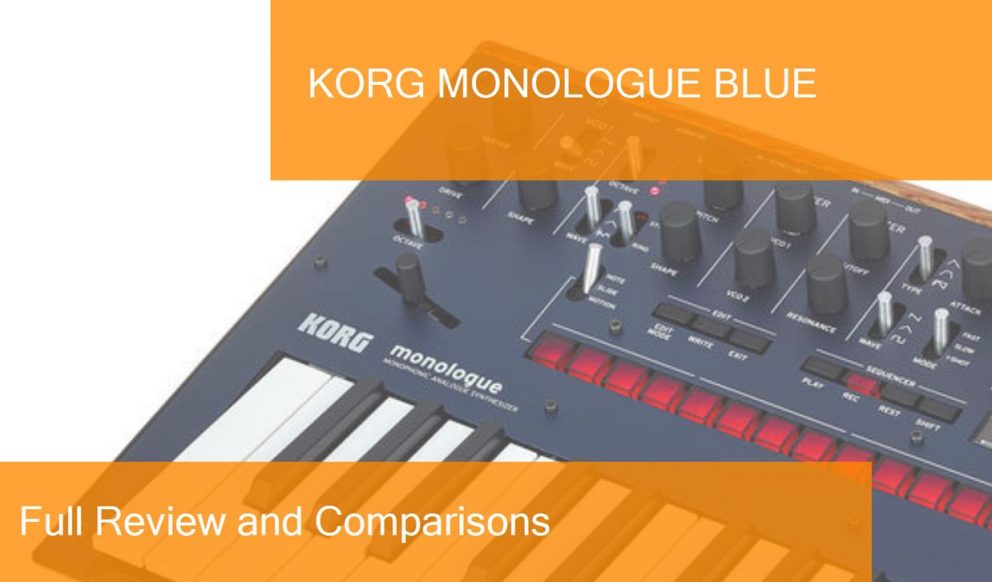- Home
- Author's Archive:
Review Synthesizers Korg Volca Kick. Where to buy it?
I’ll tell you how this post is built. First I list the features of the Korg Volca Kick synthesizer. Then you have a video or two, purchase links and useful comments from other users and then you have one of the most useful parts; comparison tables with similar keyboards so you can compare.
- Type: Analogue synthesis
- Max. polyphony (Number of notes that can sound at once. This includes songs that sound at once. So if you play over an accompaniment sound, more notes will accumulate.): 1 Voice
- Structure: VCF (no input, MS-20 Rev1 filter as resonator), pulse generator, VCA, analogue DRIVE analogue TONE, MS-20 Resonator: Pitch/Octave, Bend, Time
- Pulse: Colour, Level
- Amp: Attack, Decay
- Tone: Low pass filter, 12 dB / oct.
- LED display
- Integrated speaker
- Sync input and output: 3.5 mm miniature mono speaker
- midi (MIDI allows you to do such wonderful things as connect the keyboard to the computer, record a soundtrack and with certain programs pass with a click what you have played to musical notes in a score. MIDI tracks store information from musical notes) in
- Headphone output: 3.5 mm mini stereo jack
- Power supply via 6 AA batteries or via optional power KA-350 (batteries and energy supply not included)
- Dimensions (W x H x D): 193 x 115 x 46 mm
- Weight: 377 g
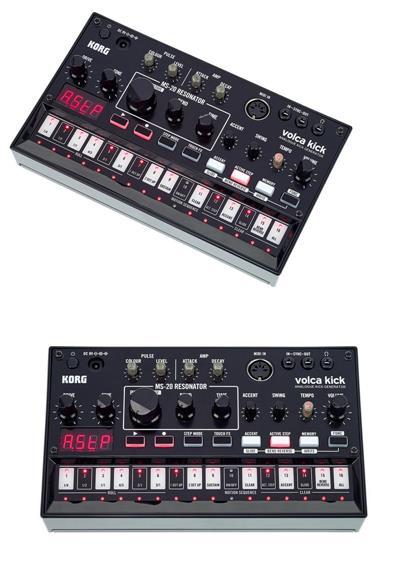
This keyboard usually has a price around 109.00 €
Now that we’ve seen the features of this synthesizer Korg Volca Kick watch these related videos to learn more.
Post you may be interested in
- Ranking with the best synthesizers
- My selection of cheap synthesizers.
- Synthesizers Basic Guide.
- KORG Synthesizers
Some comments from people who come to the forum about this model:
Comment:
Its one of my first analog music hardware and i like it!
Comment:
It works as a kick demonstrably nonetheless it also can do massive sub-basslines, additionally some good videos of men and women using it to relax and play melodies via MIDI [see Oscillator Sink].
Pros:
Massive noise.
Same form-factor as the other volcas.
Fun to mess around in!
Cons:
Some blips in the beginning of pattern-chained sequences.
Relatively low feature-to-cost ratio (touch FX are cool tho)
Conclusion:
It’s most likely the best volca, for some reason it’s simplicity speaks to me.
Korg Volca Kick vs Korg Monotron Delay
The synthesizer Korg Volca Kick is usually 60 € more expensive than Korg Monotron Delay.
|
Korg Volca Kick |
Korg Monotron Delay |
|---|---|
|
|
And then a video of the synthesizerKorg Monotron Delay
If you want to know more about this option, click on the following link to see the Korg Monotron Delay review
Korg Volca Kick vs Korg Volca FM
The synthesizer Korg Volca Kickis usually 19 € cheaper than Korg Volca FM, but the difference is so small that this can vary..
|
Korg Volca Kick |
Korg Volca FM |
|---|---|
|
|
And then a video of the synthesizerKorg Volca FM
If you want to know more about this option, click on the following link to see the Korg Volca FM review
Korg Volca Kick vs Korg Volca Bass
The synthesizer Korg Volca Kickis usually 26 € cheaper than Korg Volca Bass, but the difference is so small that this can vary..
|
Korg Volca Kick |
Korg Volca Bass |
|---|---|
|
|
And then a video of the synthesizerKorg Volca Bass
If you want to know more about this option, click on the following link to see the Korg Volca Bass review
Korg Volca Kick vs Korg Volca Keys
The synthesizer Korg Volca Kickis usually 20 € cheaper than Korg Volca Keys, but the difference is so small that this can vary..
|
Korg Volca Kick |
Korg Volca Keys |
|---|---|
|
|
And then a video of the synthesizerKorg Volca Keys
If you want to know more about this option, click on the following link to see the Korg Volca Keys review
Where to buy the synthesizer Korg Volca Kick
Amazon
- Free Shipping and possibility of shipping in one day with Amazon Premium.
- Full Guarantee but they are no experts in music equipment.
- Sometimes better price.
- He’s got worse stock than Thomann.
Thomann
- Free Shipping.
- Full warranty. If you have any problems, they take care of everything.
- 100% reliable payment.
- Leader in trouble-free shipping.
- Usually Best price.
- Best Reputation: They are the leading online store in Europe and have the best catalogue and information.
Also look at these models with a similar price and features:
- SOMA Ether V2
- Behringer MS-1-BK
- Behringer MS-1-BL
- Behringer MS-1-RD
- Arturia MicroFreak
- Akai MPK miniplay
- Korg Volca Keys
- Korg Volca FM
- Korg Volca Modular
- Teenage Engineering PO-12 rhythm
- Korg Monologue Silver
- Korg Volca Bass
- Korg Monologue BK
- Korg Volca Nubass
- Moog Theremini
- IK Multimedia UNO Synth
- Teenage Engineering PO-16 factory
- Teenage Engineering PO-20 arcade
- Yamaha Reface DX
- Teenage Engineering PO-28 robot
- Korg Monologue Blue
- Korg Volca Kick
- Arturia MicroBrute
- Teenage Engineering PO-14 sub
- Widara Distant Voices Theremin
- Teenage Engineering Ultimate Cocktail PO Superset
- Teenage Engineering Ultimate Punch PO Superset
- Arturia MicroBrute Creation Edition
- Korg Monotron Duo
- Teenage Engineering PO-24 office
- Korg Monotron Delay
- Korg NTS-1
Review Synthesizers Moog Sub Phatty. Where to buy it?
I’ll tell you how this post is built. First I list the features of the Moog Sub Phatty synthesizer. Then you have a video or two, purchase links and useful comments from other users and then you have one of the most useful parts; comparison tables with similar keyboards so you can compare.
- 25 Semi-weighted keys
- 2 Oscillators
- 1 Sub-oscillator
- Noise generator for sound effects
- Moog filter
- Analogue Multi-drive Circuit for distortions
- 31 Knobs and 13 buttons
- Pitch fold and modulation wheel
- DAW integration with Plug-In editor via midi (MIDI allows you to do such wonderful things as connect the keyboard to the computer, record a soundtrack and with certain programs pass with a click what you have played to musical notes in a score. MIDI tracks store information from musical notes) via USB
- 16 Presets
- CV / gate inputs
- 1x Line input 6.3 mm mono jack
- 1x Line out 6.3 mm mono jack
- Headphone output
- MIDI in/out
- USB

This keyboard usually has a price around 719.00 €
Now that we’ve seen the features of this synthesizer Moog Sub Phatty watch these related videos to learn more.
Post you may be interested in
- Ranking with the best synthesizers
- My selection of cheap synthesizers.
- Synthesizers Basic Guide.
- MOOG Synthesizers
Some comments from people who come to the forum about this model:
Comment:
I did think about a modular but had been obsessed about the worthiness the SP offered whenever thought to be an accumulation of modular units…plus genuine Moog noise and filter.
Pros:
+ this has the ‘Moog sound’
+ well built…robust, solid
+ great design, interface & ergonomics
+ very tweakable, mini-modular (without cables)
+ good, stable pc software integration…VST editor for DAW’s or standalone
+ support & ongoing development from Moog: warranty/software updates
+ priced well; the best value
Downers:
– approx. 1/3 of performance functions are accessed via a ‘shift’ switch which alternates the panel that is front to brand new functions. Not really much of a problem with all the software editor (which shows all of the controls/functions) but it will most likely simply take me personally per year to learn all the hidden functions…so no issue into the long-lasting.
– when a fresh preset is selected there isn’t any indicator of this status (brand new place) of the panel settings; these can only be decided by sweeping the control and paying attention for modifications. In use it’s not as big a problem because it sounds & the program editor displays the concealed functions.
In conclusion, there are no genuine negatives that cannot be overcome over time & practice and/or the program editor. I’ve continue reading the Moog forum that there might be a software arpeggiator, a rise in presets & other useful functions in future updates…that would cover all of the desires I could reasonably expect.
I still lust after the Sub37: duophonic; full front panel controls; bell & whistles; bigger better keyboard; etc. – but I’m pleased with the sound and the best value of this SP. It’s got the Moog sound & it vibes : -)
Comment:
Some individuals have said that the keyboard is to small at 2 octaves, however in
use I had no difficulty playing bass lines and solos.
As long as you know what octave you are going to need and set it before
you begin only the most outlandish jazzy trippy solamente will catch you out.
I make use of it and want it more than my voyager.
The sound is more versatile and seems good playing
anything from jazz, funk, pop music and stone.
Not only restricted to techno or spacy ambient Vangelis kind music.
It has a snappy amp and filter with a funky 70’s 80’s vibe.
You don’t have quick access for some associated with the more descriptive editing unless you utilize
the computer software editor.
The Sub Phatty dosage NOT come because of the editor pc software on disk, you must register
it on Moog webpage before you decide to can install it.
I had no dilemmas utilising the software in standalone windows 7 and as a vst
in 16 bit Cubase, but had fall outs in the 64 bit vst variation.
I since read that moog are aware and already working on a solution.
I think the Sub Phatty is Moog musical’s best sounding synth for the brand new generation of
moog synths.
Moog Sub Phatty vs Behringer DeepMind 12
The synthesizer Moog Sub Phatty is usually 20 € more expensive than Behringer DeepMind 12, but the difference is so small that this can vary..
|
Moog Sub Phatty |
Behringer DeepMind 12 |
|---|---|
|
|
And then a video of the synthesizerBehringer DeepMind 12
If you want to know more about this option, click on the following link to see the Behringer DeepMind 12 review
Moog Sub Phatty vs Korg Kross 2-61
The synthesizer Moog Sub Phatty is usually 84 € more expensive than Korg Kross 2-61.
|
Moog Sub Phatty |
Korg Kross 2-61 |
|---|---|
|
Connections:
|
And then a video of the synthesizerKorg Kross 2-61
If you want to know more about this option, click on the following link to see the Korg Kross 2-61 review
Moog Sub Phatty vs Roland Juno-DS 61
The synthesizer Moog Sub Phatty is usually 84 € more expensive than Roland Juno-DS 61.
|
Moog Sub Phatty |
Roland Juno-DS 61 |
|---|---|
|
Includes most of the JUNO-Di plus sounds plus brand new acoustic pianos and E-Pianos, organ sounds plus much more.
|
And then a video of the synthesizerRoland Juno-DS 61
If you want to know more about this option, click on the following link to see the Roland Juno-DS 61 review
Where to buy the synthesizer Moog Sub Phatty
Amazon
- Free Shipping and possibility of shipping in one day with Amazon Premium.
- Full Guarantee but they are no experts in music equipment.
- Sometimes better price.
- He’s got worse stock than Thomann.
Thomann
- Free Shipping.
- Full warranty. If you have any problems, they take care of everything.
- 100% reliable payment.
- Leader in trouble-free shipping.
- Usually Best price.
- Best Reputation: They are the leading online store in Europe and have the best catalogue and information.
Also look at these models with a similar price and features:
- Behringer Odyssey
- Critter & Guitari Organelle M Grey
- Behringer Vocoder VC340
- Critter & Guitari Organelle M Blue
- Behringer Poly D
- Korg Minilogue XD
- Novation MiniNova
- Roland AX-Edge Black
- Moog Grandmother
- SOMA Lyra-8 Black Beast
- SOMA Lyra-8 White Angel
- Teenage Engineering OP-Z
- Roland Juno-DS 88
- Korg Kross 2-88MB
- Behringer DeepMind 12
- Moog Etherwave Theremin Ash
- Arturia MiniBrute 2
- Korg microKORG
- Korg Kross 2-88
- Modal Argon8
- Novation Bass Station II
- Korg Kross 2-61
- Behringer DeepMind 6
- Korg Minilogue
- Roland Juno-DS 61
- Roland JD-Xi
- Korg MS-20 mini
- Moog Etherwave Theremin Plus
- Yamaha Reface CS
- Yamaha Reface YC
- Roland Juno-DS 61B Black Edition
- Yamaha Reface CP
- Korg Triton taktile 49
- Roland System-1
- Yamaha MX49 V2 Black
- Roland AX-Edge White
- Yamaha MOXF 6
- Moog Sub Phatty
- Teenage Engineering PO-30 Superset
- Waldorf Blofeld Keyboard Black
- Yamaha MX88
- Roland Juno-DS 76
- Korg Minilogue PG
- Waldorf STVC
- Korg King Korg Black
- Moog Etherwave Theremin Kit Plus
- Roland SH-01 Gaia
- Studiologic Sledge 2 Black Edition
- Korg microKorg XL +
- Korg microKORG S
- Waldorf Blofeld Keyboard
- Yamaha MX61 V2 Black
- Yamaha MX61 V2 Blue
- Yamaha MX49 V2 Blue
- Korg Minilogue XD Pearl White
- ARP Odyssey
- Sonicware ELZ 1
- Roland FA-06
- Korg Krome EX 61
Review Synthesizers Korg Monologue Blue. Where to buy it?
I’ll tell you how this post is built. First I list the features of the Korg Monologue Blue synthesizer. Then you have a video or two, purchase links and useful comments from other users and then you have one of the most useful parts; comparison tables with similar keyboards so you can compare.
- 1 Voice
- 25-Key keyboard
- Monophonic 16-step sequencer notes along with up to 4 parameters
- 100 Program presets: 80 presets + 20 user-created programs
- Display with preset, sequencer and waveform show
- Power supply via 6 AA batteries or external power supply (perhaps not included)
- USB
- midi (MIDI allows you to do such wonderful things as connect the keyboard to the computer, record a soundtrack and with certain programs pass with a click what you have played to musical notes in a score. MIDI tracks store information from musical notes) In / Out
- Sync In / Out: 3.5 mm Mini Jack
- 1 x Line input: 6.3 mm jack
- 1 x Line output: 6.3 mm jack
- Headphone output: 6.3 mm jack
- Colour: Blue
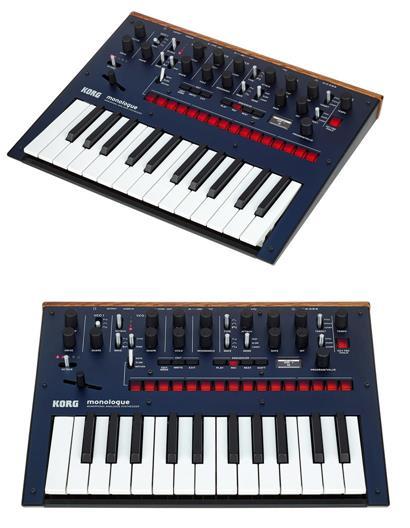
This keyboard usually has a price around 253.00 €
Now that we’ve seen the features of this synthesizer Korg Monologue Blue watch these related videos to learn more.
Post you may be interested in
- Ranking with the best synthesizers
- My selection of cheap synthesizers.
- Synthesizers Basic Guide.
- KORG Synthesizers
Some comments from people who come to the forum about this model:
Comment:
There are numerous good features just like the form that allow for modulations nad noise modifying which make the monologue go beyond its anticipated noise design and opportunities. It is very straightforward, and rich in sound, typical korg analog sound I think. The sequencer is sadly a bit limited, but by combining patches this is often solved easily. The keyboard is nice, yes semi mini tips aren’t the devil 🙂 so for this price I think they did a job that is excellent. A fantastic suprplus it exceptional for live gigs, or for music design on the highway for me personally can be the compact nature and portability associated with synth, which makes. Certainly one of todays synths you should provide atry!
Comment:
Chaning some parameters sometimes requires to dig into menus hidden behind sequencer buttons. A bit uncomfortable in the beginning.
there is one thing that should be revealed when purchasing this synth – it comes down without energy adapter. Thomann should offer it as a kit with a one that is suitabletook me quite a while to figure out which one would fit well).
Korg Monologue Blue vs Arturia MicroBrute
The synthesizer Korg Monologue Blueis usually 26 € cheaper than Arturia MicroBrute, but the difference is so small that this can vary..
|
Korg Monologue Blue |
Arturia MicroBrute |
|---|---|
|
|
And then a video of the synthesizerArturia MicroBrute
If you want to know more about this option, click on the following link to see the Arturia MicroBrute review
Korg Monologue Blue vs Korg microKORG
The synthesizer Korg Monologue Blueis usually 76 € cheaper than Korg microKORG.
|
Korg Monologue Blue |
Korg microKORG |
|---|---|
|
|
And then a video of the synthesizerKorg microKORG
If you want to know more about this option, click on the following link to see the Korg microKORG review
Korg Monologue Blue vs Novation MiniNova
The synthesizer Korg Monologue Blueis usually 69 € cheaper than Novation MiniNova.
|
Korg Monologue Blue |
Novation MiniNova |
|---|---|
|
|
And then a video of the synthesizerNovation MiniNova
If you want to know more about this option, click on the following link to see the Novation MiniNova review
Korg Monologue Blue vs Yamaha Reface CP
The synthesizer Korg Monologue Blueis usually 60 € cheaper than Yamaha Reface CP.
|
Korg Monologue Blue |
Yamaha Reface CP |
|---|---|
|
|
And then a video of the synthesizerYamaha Reface CP
If you want to know more about this option, click on the following link to see the Yamaha Reface CP review
Where to buy the synthesizer Korg Monologue Blue
Amazon
- Free Shipping and possibility of shipping in one day with Amazon Premium.
- Full Guarantee but they are no experts in music equipment.
- Sometimes better price.
- He’s got worse stock than Thomann.
Thomann
- Free Shipping.
- Full warranty. If you have any problems, they take care of everything.
- 100% reliable payment.
- Leader in trouble-free shipping.
- Usually Best price.
- Best Reputation: They are the leading online store in Europe and have the best catalogue and information.
Also look at these models with a similar price and features:
- SOMA Ether V2
- Behringer MS-1-BK
- Behringer MS-1-BL
- Behringer MS-1-RD
- Arturia MicroFreak
- Akai MPK miniplay
- Korg Volca Keys
- Korg Volca FM
- Korg Volca Modular
- Teenage Engineering PO-12 rhythm
- Korg Monologue Silver
- Korg Volca Bass
- Korg Monologue BK
- Korg Volca Nubass
- Moog Theremini
- IK Multimedia UNO Synth
- Teenage Engineering PO-16 factory
- Teenage Engineering PO-20 arcade
- Yamaha Reface DX
- Teenage Engineering PO-28 robot
- Korg Monologue Blue
- Korg Volca Kick
- Arturia MicroBrute
- Teenage Engineering PO-14 sub
- Widara Distant Voices Theremin
- Teenage Engineering Ultimate Cocktail PO Superset
- Teenage Engineering Ultimate Punch PO Superset
- Arturia MicroBrute Creation Edition
- Korg Monotron Duo
- Teenage Engineering PO-24 office
- Korg Monotron Delay
- Korg NTS-1

